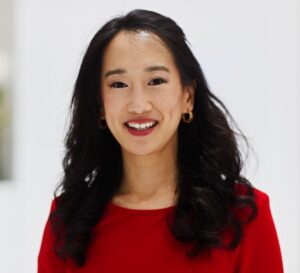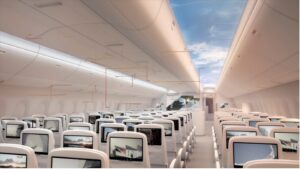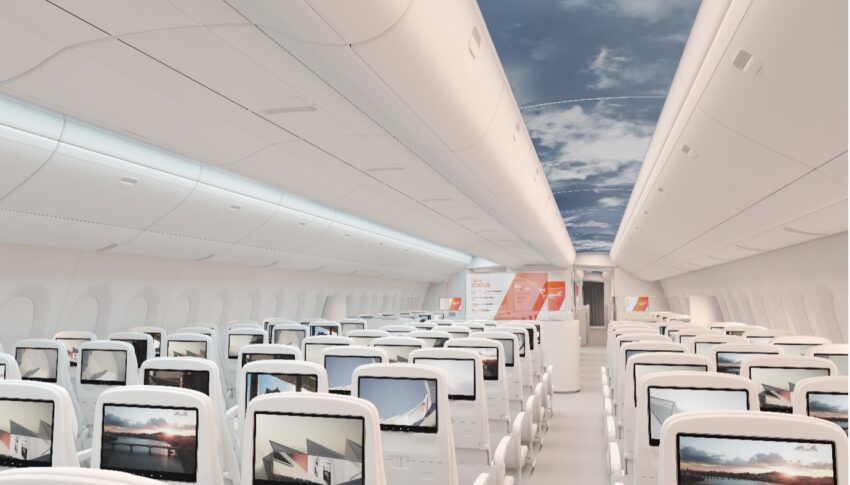Read our series of interviews with the people who are making the Yocova platform come alive. Here we speak to Verena Bintaro, Head of Marketing & Public Relations at AERQ, about digital transformation in the cabin, how this can improve passenger experience, and provide new opportunities for airlines.

Verena Bintaro, Head of Marketing & Public Relations at AERQ
Verena Bintaro is Head of Marketing & Public Relations at AERQ, a joint venture between Korean electronics powerhouse LG Electronics and German MRO expert Lufthansa Technik. AERQ’s mission is to enable airlines to revolutionise cabin experiences and help them embrace new business opportunities. AERQ has developed AERENA, a new platform for digital engagement, empowerment and intelligence, which gives airlines the opportunity to upscale passenger experience and open up new revenue channels.
Verena speaks to aviation journalist John Walton, to explain more about AERQ, how its digital platform AERENA is transforming the digital cabin landscape, some of the challenges faced, and what she thinks the cabin experience could look like in the future.
What is AERQ, and what does it do?
“AERQ is a joint venture between LG Electronics and Lufthansa Technik, based in Hamburg, Germany. We were founded back in 2019 and started with about 30 employees but we have grown significantly over the past few years, now with around 250 employees from 40 countries. Our parent companies have extensive knowledge of both electronics and aviation, so AERQ brings this together to help airlines revolutionise cabin and passenger experiences and take advantage of new business opportunities.”
What does the digital transformation of a cabin look like?
“Well, pretty much everyone these days has a smartphone, tablet or a laptop and has easy access to information and entertainment, but there’s a huge gap between what’s available on the ground and in flight. It’s pretty much accepted that on a long-haul flight you get access to some entertainment and internet, but I think, as an industry, we need to open our minds to the fact that we can offer more. Airlines are looking for new solutions but such change takes time and significant investment. And that’s where AERQ comes in, because we can help to take the digital transformation of the cabin to a new level. We believe in going beyond what is currently out there and giving passengers access to a similar level of entertainment and connectivity to what they get on the ground.”

Image courtesy of AERQ
What market gaps is AERQ addressing, and how?
“We’re empowering airlines to create a more customised digital passenger experience onboard, while at the same time unlocking new business opportunities and introducing new technologies. It’s about building an ecosystem in and around the aircraft with partners across the aviation industry and, more importantly, beyond. We launched AERENA back in 2021, as a platform for digital engagement, empowerment and intelligence. It’s now creating revenue, savings and growth through an open IT platform, enabled by an in-seat system and digital cabin signage. In a nutshell, AERENA facilitates greater passenger engagement onboard the aircraft, leading to a better understanding of passenger needs and behaviours, which opens up new opportunities for airlines through advertising, ecommerce, destination services and more. We also launched the AERENA Experience Studio, which gives airlines complete control of the inflight cabin experience. By logging into the website, airlines can access the entire digital experience, update media content, customize the user interface and manage all apps in one place. We’re using a cloud-based infrastructure to channel a new media supply chain, leading to much shorter processing time. What may have taken 60 to 90 days previously, can now be achieved in less than a week, so with AERENA, airlines can benefit from both time and cost savings. The AERENA Experience Studio offers remote preview, which enables virtual testing of passenger UI and apps, and can provide a detailed overview of system health, plus a one stop shop for advertising, so it includes a number of different functionalities in a single space, where airlines have complete overview and control.”
How does this digital transformation translate into airline operational benefit?
“Well, for airlines, time, flexibility and agility is key. For example, airlines could customise onboard digital services for a season, or even something like a large concert or sporting event and then easily change it once that time bracket had passed, making sure the content offered was relevant. On the operational side, there are many opportunities to generate new revenue and AERQ is looking to partner with airlines to unlock these. This can be along the lines of gaming, onboard e-commerce services and advertising, but also linking in destination service providers, for example making it possible for a passenger to purchase a ticket for their destination, while onboard the aircraft.”
How do you deal with the many legacy systems within aviation?
“Obviously aircraft infrastructure and cabin installations are complex technologies that cannot be replaced on an ad-hoc basis and are tied to a large investment. Usually, a cabin lifecycle is around eight to ten years and sometimes longer. Currently we’re seeing a wave of modification requests for, for example, the Boeing 787, which was first delivered in 2011, so the cabins are reaching the end of their lifecycle. For these, the airlines have the opportunity to move from legacy systems to our digital platform and take advantage of the speed, flexibility and agility it offers. We can offer so much more than just movies and music, and move towards what is trending on the ground. We want to be a partner to airlines and, being a joint venture, collaboration is in our DNA. With LG Electronics as one of our parent companies, we get access to the latest technologies, and we want to translate these to what is possible in the cabin.”
How do you ensure that airlines can use new generations of technology on older hardware?
“Our platform has the ability to host traditional web applications with little effort, but you do need to make some adjustments. I think the biggest challenge is actually having the different interfaces between the air and the ground, particularly regarding large displays, such as 32 inch in first class. In general, applications are not really optimised for these screen sizes, so this is a challenge we need to tackle. The biggest difference with AERENA is that it is designed from the ground up and we don’t have any legacy software.”
What are the challenges regarding the gap between web app standards and the hardware environment?
“As I mentioned, a key challenge is around optimizing content for displays and there is definitely an appetite from airlines to provide larger screen sizes, particularly for business and first classes. We’ve considered the different types of technologies, for example LCD verses OLED, and there are advantages and disadvantages to both. Ultimately, we’re working to provide the best solution, or in fact, the solution that makes the most sense to an airline and will be the most beneficial. We’re experts in digitalisation, but we’re also working with other experts such as cabin monument suppliers or seat vendors, to find the best solution out there. We’re basically looking at how we can find solutions to make the in-flight experience as enjoyable as possible, for both passengers and crew.”
What does the most positive picture of a digitalized aviation industry look like?
“I think the dream is to have any content, any time, that is relevant to each individual passenger. It won’t be a one size fits all solution, it will adapt to people and make sensible recommendations based on data analytics and advertising that is relevant to the passenger. The passenger would also be able to control other things via the display to make their flight as comfortable as possible, such as lighting and temperature control. And another key improvement would be providing people with disabilities with meaningful technology to improve their flying experience. I’m really looking forward to seeing the transformation we can bring about!”
Author: Yocova, with special thanks to John Walton
Published 26 September 2023
Watch John Walton and Verena Bintaro discuss these topics in person.
To view the full podcast episode register for Free Yocova Membership,
log in and head to Workspace > Learning.




